Part IIIA/III: ACO for Retailers, Brands and Agencies: Agentic Commerce Optimization (ACO) Foundations
Four Essential Foundational Concepts for preparing your Products for Agentic Commerce: 9-step sequential system, Canonicalization, Focus on Owning the Product Card, and Content and Context.
This is Part III of our three part series on GenAI Engine Optimization for retailers. This builds linearly and we’ve added a ton of subscribers since we started so I strongly recommend going back to Part’s I and II to get those concepts before we jump into the Part III
Part I - (9/3/25) - What is GEO→ACO for Agentic Commerce and What’s the Goal?
Part II - (9/10/25) - The 13 Agentic Commerce Pitfalls: with real-world examples.
Part IIIA - (10/21/25) Agentic Commerce Optimization Foundations: (**You are Here**) ACO 9-Step Sequential System, Canonicalization, Own the Product Card, Content+Context. Before we get into the ACO Playbook, we need to cover 4 Foundational Concepts that will help explain the ‘why’ of the optimizations.
Part IIIB (10/29/25) The Agentic Commerce Optimization Playbook - 9 Easily Implementable Strategies and Tactics to dramatically improve your Agentic Commerce readiness, avoid the 13 pitfalls from Part II , and optimize the Seven Agentic Shopping Engines for maximum sales in Holiday ‘25.
A couple of editorial/housekeeping notes:
A couple of quick housekeeping notes:
Sharp eyed observers will notice that we originally intended this to come out 9/30/25. Turns out that was a big day and we dropped everything for ChatGPT Instant Checkout and made the decision to inject another three part series chronologically in the middle of this one at the risk of confusing everyone. This was the correct decision because I’m confident we are going to look back at 9/30/25 as a seminal moment when the future direction of Agentic Commerce was not only set in stone, but accelerated dramatically.
10-15 of the smartest people I know have been working on this problem intensely for the last year and what we’ve learned is this problem (Agentic Commerce Optimization) is complex and deep enough we could write volumes on it. By the time we finished, 90% of it would have changed as this is a very dynamic environment. With that in mind, for this playbook, we’re going to keep it higher level with a focus on frameworks and strategies we know will be in the quadrant of ‘relatively easy to implement’ and ‘will stand the test of time’ as well as ‘work across Agentic Commerce Engines’.
If we do show examples of specific SKUs or engines, this is because they illustrate something we have seen across millions of SKUs and all the level 2 and level 3 (Find/Buy tiers of our adoption matrix), we are not picking on or showing something that is a ChatGPT/Perplexity/Gemini/Copilot specific optimization.
You can see that I’ve expanded Part III into a part A and B. As I started writing this, the goal was for the ACO Playbook to be a tight, super-dialed in reference that you bookmark, print, save as PDF and come back to over and over. I realized as I got into it that there were four foundational concepts that needed to be covered separately to keep the ACO Playbook as tight as possible.
Introducing ACO: Agentic Commerce Optimization.
Let’s start Part III here with some definitions, because there’s a ton of confusion right now. You may have heard of one of these:
GEO - GenAI Engine Optimization
AEO - Answer Engine Optimization
AIEO - AI Engine Optimization
LLMO - Large Language Model Optimization
AIO - AI Optimization
We’ve tried on some of these, you can see the OG name of this was GEO, but the problem to me is none of these acronyms fit our need which is: ‘what does a merchant need to do to optimize for transactions’. AEO/GEO are optimizing for general traffic (in any category, not specific to ecommerce/agentic commerce) and frequently as part of that the recommendation is the generation of a lot of LLM spammy content like listicles and top X lists. In the world of commerce, our main content is product data. Sure there is other content on any retailer’s website, but to optimize selling things, transactions, you don’t want what is currently called AEO/GEO, you need something else.
When ChatGPT branded the underlying technology of Instant Checkout ACP: Agentic Commerce Protocol, we knew that Agentic Commerce is the official name for their advanced shopping functionality. Therefore, it’s now very natural and makes sense to go with ACO going forward.
Welcome to the era of Agentic Commerce Optimization (ACO)!
Foundations of ACO
There are four foundational concepts that our ACO playbook is built on.
The Importance of Content and Context - Feed the LLMs!
Understanding Canonicalization (c14n) -Where Product Cards are born
Focus on Owning the Product Card - Eye on the prize
Nine Sequential Steps for Agentic Commerce Optimization
Foundation 1: Give LLMs What They Crave!
Remember that while we’re saying Agentic Commerce, it’s built on GenAI Answer Engines. Answer Engines are built on the core technology of LLMs.
As an ecosystem between buyers and sellers, on both sides we have had 20+ years of training and optimizing for what will become an old behavior - keyword searching. At both the search engine level (Google) and the on-site search level, we have hyper optimized for keyword search. In keyword-search-land the consumer has been trained that ‘less is more’ - they typically enter 4 keywords. However in Answer Engine-Land, it’s the opposite - over 20 words in the prompt at the ‘find’ level, but before that there maybe 2-5 levels of conversation with even more words.
At a core technological level LLMs crave two things:
Content - LLMs even in what we call post-training or inference want as much content as they can get. This allows them build a complex ‘mental map’ so when a consumer searches LLMs can tie together contextual clues within that content for a match that often times feels magical. How did it know I wanted that? My friend told me recently he has 4 boys and they play basketball when they travel. They picked a summer getaway using an LLM because it was the only way to find a location that had a basketball court. The LLM magically ‘just knew’. Why? Content! (probably review content in this case).
Context - Once an LLM has all that product content in it’s digital brain. It uses all the context the consumer is giving it to make matches. Remember the consumer is several turns into a convo, the Answer Engine has memory so remembers past purchases, sizing information, maybe an occasion she is shopping for a who she is buying a gift for or the meal recipe/plan and it knows her family’s allergies and food preferences.
These two concepts (say it with me content and context) are super-foundational and should always be on the merchant’s mind. These are the two things you can focus on today to have the biggest impact. We’ve discovered it’s very very hard to undo 20yrs of training and best practices and get in this new mindset, so let’s dig in a bit more so you understand why this is so important and give some examples.
The Agentic Commerce Content Problem
Modern PDPs have gotten shorter and shorter text-wise, but more rich with multimodal (videos and images) data. One common misperception is that the LLMs are going to ‘read’ your images. While they have this ability, in the context of crawling a retailer’s site, they do not look for data in there, they just capture the URL.
When we get to a real-world example shortly, you’ll see this hyper optimization is so bad that I don’t think it’s hyperbolic to say that Agentic Commerce is going to cause a content crisis. This is a huge problem with a very very large scale that’s simultanously critically important to solve and very hard to solve. Content investment today (and context) is what’s going to separate the winners and losers in Agentic Commerce. By my estimate, the modern PDP has 5-10% of the content needed to be successful, so need a 10-20x improvement.
The Agentic Commerce Context Crisis
For context, because of the content problem and the keyword optimization there is now a huge mismatch of context between the buyer and the seller:
Buyer - The Answer Engine has a TON of context about the buyer and it’s growing every day.
Seller - The seller isn’t giving the answer engine much content and what it does index is a bunch of keywords, often repeated in an attempt to keyword spam.
What is product-level context? The answer engines need to know how the product will be used. What scent profile is it? What’s it pair well with? What does it not go with? Is there an occasion it’s great for or an age group that has an affinity?
This context informs the WHY behind the product (prior to ACO we’ve focus on the WHAT and keywords)- why should an answer engine surface and recommend this product to the buyer. Much of this comes back to why the product was created in the first place - who was the intended customer?, what were the use cases the product optimizes for?, etc.
The Agentic Commerce content challenge is large, the context problem is even bigger. Most PDPs have 0-2% of the context they should have.
Final thought - Content and Context are like peanut butter and jelly, they really go best together. Think of content as the energy providing ‘calories’ and context is the ‘protein’ macro ingredient inside those calories. Images and keywords all stuffed in there are empty calories to the engines. Google is the opposite, it’s protein is keywords. Conversely, Google and other keyword-based systems can’t pick up much from the all the longer content and context - so we end up with optimized PDPs as a loose collection of keywords.
Let’s tie this together with a real-world example.
Real World Example of the Content and Context Problem:
I realize a lot of this content and context talk so far is very ‘ivory tower’ and conceptual. I’m going to show you how bad it is with a real-world example. Again, this is not picking on a particular retailer or brand, it’s an example I randomly came across while researching a gnarly customer product card issue in another category and brand.
Here’s a PDP for a pair of women’s Levi Jeans on Kohl’s.
If you’re new to PDPs (Product Detail Pages), I’ll use this opportunity to show you how we in the industry look at this and how an LLM will as well:
In the top part here, we see:
The title: “Women’s Levi’s Classic Straight-Leg Jeans”
We see there are ratings (above image) that are 4.2 and links to see the detailed reviews
The Levi’s brand is linked at the top (to a Levi brand store)
There’s a price - $49.99 and this is what we call strike-through pricing, the original was $59.50
Then there is loyalty program information (Kohl’s cash)
Then on the right side we have variations. This product has a three dimension variation matrix color X length X size
The sizes here are unusual in that they have the traditional jean waist and then in parentheses “US sizing equivalent” (spoiler alert, this is going to not make the LLMs happy). Here’s a zoom in→
There are around 10 images in a carousel. It looks like javascript, the llm crawler is going to miss all of that, but get the three images.
Finally on this screen shot we have the shipping options/delivery SLA details.
The images have a lot of content in them which humans will get, but not a LLM crawler, so it’s 100% blind to this content in these two images→
Scrolling down the PDP we finally get to product details, let’s look to see how much content and context is provided….
(there is more behind the ‘more’ button. Will the crawler click it - probably, but hard to say. Why is it back there?
Here’s the content the engine is going to pull out:
Title: “Made with durable denim, these women’s straight-leg jeans from Levi’s are designed to sit above the hip, and the traditional five-pocket style provides plenty of functional storage.” and if you click the ‘more’ button→
“PRODUCT FEATURES
Denim construction
5-pocket
Zipper fly
FIT & SIZING
Short: 28-in. inseam
Medium: 30-in. inseam
Long: 32-in. inseam
Midrise sits above the hip
Mid rise: 9.75-in
Straight leg opening: 14.5-in
Straight-leg cut
FABRIC & CARE
Cotton, polyester, elastane; Cotton, elastane
Machine wash
Imported
SUSTAINABILITY FEATURES
Supports more sustainable cotton farming
SKU #47865716”
IRL Content Problem
This is a perfect example, do you see the complete lack of content here and the over optimization on keywords? Look under ‘fabric & care’ “Cotton, polyester, elastane; Cotton, elastane”. Why do you think it says cotton and elastane twice? This page has been so SEO optimized, it has completely stripped out the human readable and interesting content and replaced it with keyword stuffing.
Do you see what else is obviously missing? Don’t Levi’s all have a three digit model number, remember 501 Jeans? What’s the ‘model number’ on this. It’s not “SKU #47865716”
IRL Context Problem
Imagine there’s a young lady in Texas going to the Houston rodeo and she’s looking for a pair of rugged jeans that still look good, stonewashed in women’s size 5 and she’s taller. Does this page have the context for the engine to match her context to the product context? Nope. It’s not going to be recommended. It has basically chosen to opt out of selling via Agentic Commerce.
This page has zero context except for maybe if we squint: “sit above the hip” and “functional storage”. I don’t shop for women’s jeans (well I do for work) but I have a feeling these aren’t the contextual clues the shopper will be providing the Answer Engine.
What Good Looks Like
For this example, if we go to the brand site, Levi’s and look here. While this PDP has good images, the variation matrix is much simpler which is good and doesn’t have the unusual mixing of size standards - any crawler will have a much better time with this. Here’s the meaty part:
You can tell by reading this there is a ton more context. Instead of ‘imported’ it says “made in Egypt, Pakistan”. It has detailed washing instructions vs. “machine wash”. it has contextual clues like “vintage inspired look” and “old-school vibes”. If someone is looking for modern, this will let the engine know to not offer these, conversely if they want new with a vintage feel, bingo! It even goes onto explain what Ecovero is vs. ‘Cotton, polyester, elastane; Cotton, elastane”.
To keep riffing on this, the Amazon ASIN is interesting (I realize they block all bots, just illustrating here) - not a lot of content or context. There’s a very cool fitting guide on the page but it’s all javascript and image embed so blind to crawler. But scroll down and you get some really great content in the reviews.
I like to tell retailers, what the engines really crave is a 80 page pdf of your product - every conceivable attribute and context for your product possible. The super-set of product content.
What Not to Do: Focus on Sentiment and Off-Site Content/Reviews First
We’ve met with many brands and retailers that are frustrated because their SKUs are not showing up on ChatGPT and other engines at all or incorrectly, but they are doing all the “best practice GEO stuff”. There is an exploding number of startups doing GEO/AEO (I’m going to say AEO for both going forward) and what they typically focus on is infrastructure and then super high-level content. Very broad analysis of what influences engines shows that Reddit, wikipedia and other content sites play a big role in if your content gets surfaced.
Therefore, the typical AEO playbook involves context and content, but off-site:
Make sure your company has a wikipedia page, try to get sub-company level content onto wikipedia
Plant/influence/push a lot of content to Reddit
Create ‘listicle’ and other known ‘LLM bait’ on sites under a different domain
‘Swarm’ any bad reviews with good reviews and answers, work with the site to have them removed if possible
Generate fresh ‘LLM bait’ content every 30 days
If you’re a new website or challenger brand or in a category like Fintech, Healthtech, Insurance, news, where your product content is a page or two, some of these strategies are what you should start with.
For Digital Commerce brands or retailers:
Most likely your brand is well known, you are not a challenger brand.
Also, 99% of your content is product catalog content, not general ‘about my company’ content.
Therefore you can do some of these things, but do them AFTER you have thoroughly optimized your content which has a > 90% probability of not having enough content and context first.
Follow the data
Data indicates that when using commercial prompts, consumers are “Researching new products” is the highest %’age activity.
That tells us they aren’t prompting - “what is a good shoe brand.” They are shopping by CONTEXT: “I am running a 5k this weekend that is a mix of road and trail and need a shoe for the weekend runner that has good foot support in the arch area and many shoes run narrow for me. I’m a size 11.”
We’ve noticed they are increasingly quick to get to product cards: (which is driven by product content and context), like this→
And…you guessed it Product Cards are driven by product content, not big-picture horizontal content.
Yes, ultimately you should do these AEO things, but do them last. We’ll call that step 10+. If you don’t focus on your product content first, you are putting the ‘AEO cart’ before the ‘product catalog content+context horse’ and you aren’t going to see results, especially for prompts that pop Product Cards. You essentially started at step 10
What Not to Do: Generate Lots of LLM Friendly Content
Another problematic ‘best practice’ that most AEO firms promote aggressively is: flood the zone with LLM-generated content. My concern with this strategy is it feels ‘grey-hat’. In the early days of Google organic optimization , grey-hat SEO firms pushed these kinds of strategies early on.
I know many many companies that had early SEO vendors push them down this path and then months later Google took ‘manual action’ that resulted in basically a death sentence (removal of your content from the index). We are only 1 year into Answer Engines and Agentic Commerce, please please please don’t do something today that for a quick win, that’s not going to really move the needle, but it does increase your risk of some kind of future action.
Sam Altman recently addressed this, quite specifically:
In fact in the recent (10/8/25) Sam Altman interview with A16Z at 40:25, the A16Z specifically talk about these strategies coming out of the AEO industry and ask him if they are going to do anything about it (because we all know it’s shady). Sam says:
“...This is a very sudden shift that has happened. ... we never used to hear about this like 6 months ago or 12 months ago ... And now there’s like a real cottage industry that feels like it’s sprouted up overnight ... I don’t know how we’re going to fight it yet, but people figure this out.”
Here’s how my ears hear this: “TAKE NOTICE, We know you are doing this, it is not in the spirit of what we’re trying to do here and we are working on this and will take action.” Notice he clearly says they are not thinking about IF they will counter it, we are working on HOW.
Finally, there are also vendors, usually in the ‘behind the homepage category” that are advising retailers and brands to create tons of on-site content derived from your basic product data (with no enhancements for content+context) and create 10-100 landing pages for each of them. This is 100% not necessary, plus I believe mid-term it’s likely to be a signal to the answer engines of shady behavior and something that probably will result in negative consequences. Build your pages for humans, we have many ways in the playbook to optimize and enrich that content in a 100% acceptable white-hat way and not risk any future problems and risk.
Foundation 2: Understanding Canonicalization (c14n)
There’s a common concept in ecommerce 1.0 for marketplaces and comparison shopping engines. We borrow the word from the computer science field, put an ecommerce twist on it and , voila we have Canonicalization. It’s a super long word and super-nerds (guilty as charged) like to shorten long words by just putting the number of characters omitted like i18n and a16z. This is c14n which I’ll use going forward.
The word ‘canon’ in this context means ‘the one true SKU’ and the the rest is the process of matching offers from various merchants to the true SKU. To understand the problem and the process, I’ve found this example to be helpful.
Pretend you had 4 decks of standard playing cards. There are 52 cards in a deck and there are four suits (hearts, clubs, spades, diamonds) and each suit contains 13 cards. the cards have numbers 2-10, three face cards plus one ace. With 4 decks we have 208 cards, still 4 suits, and 52 cards per suit (from the 4 decks). What if you shuffled these cards really well and were told to sort them by suit or by value/face card. That’s a great way to explain how c14n works.
To complete this task, first, you would have to look for contextual clues (suit/value/face). Sometimes you can’t canonicalize if you lack context. For example, what if these 4 decks were exactly the same on the backs and you had to separate them into the original decks - this task can’t be done because you have no contextual clue from which to guarantee you can tell the 4 decks apart. However, if the 4 decks had 4 different colors on the back of the card that would gives you the context needed to canonicalize by suit.
Now let’s forget the playing cards, but take the same concept and apply it to the world of ecommerce Let’s start with one SKU, I’ll pick Levi jeans since we were just talking about them, the same women’s straight leg SKU.
You have millions of offers in a database, you come to one that says “Levi’s Women’s straight leg jean” - you look through all the other offers and find 15 that match are or close to this product. You run a deeper analysis which says there are actually 3 canonical SKUs in there and 5 offers per. You organize that in the database. Then some guy writing a substack throws the prompt in: “I’m looking for women’s levis straight light jeans” and shows us this (I put the offers under the cards to illustrate)→
C14n is the process of sorting offers into their matching canonical SKUs (into cards for ChatGPT) and then finding all the offers that match that and then applying an algorithm to sort those offers from top to bottom. You can see here that algorithm really likes the Levi’s site. These algorithm’s are always closely kept secrets, but what did we learn about the Levi’s site vs. a retailer’s site optimized for keywords in the Content and Context session?
Yep, there’s strong evidence that your richness of content as well as price plays a huge factor. You can see here in 1 and 3 that Levi’s has the lowest price. But look at 2 🤔
Foundation 3: Keep Your Eye On the Prize: Owning the Product Card
This phase of maturity we are in with Agentic Commerce reminds me a lot of the early days of Amazon marketplace in 2006. At ChannelAdvisor, once we saw how the marketplace operated, we realized very quickly the goal would be to ‘Own the Buy Box. For the next 16 years we built solutions to solve this problem. Every couple of years a new twist would come up that reset everything (Prime/FBA, sponsored listings, etc.). Our customers that focused in on this simple and easy at first, but increasingly hard-to-achieve goal were handsomely rewarded with the lion’s share of a SKUs sales and sat on top of a platform that grew from nothing to hundreds of billions of GMV at speeds significantly higher than ecommerce overall.
This ACO Foundational concept is simple and we talked about it in part I, but it’s so important to remember, that I wanted to emphasize owning the product card before we get into the Playbook.
Foundation 4: Nine Sequential Steps for Agentic Commerce Optimization
ACO is a linear process where each step is a pre-requisite to the next step and you can’t skip steps in the process. Here’s what they look like:
The most fun/interesting parts of the playbook maybe around the more strategic optimizations around the digital shelf or pricing strategies, if you don’t put the work in the first five foundational steps, your products won’t even be in the game. This is the SEO equivalent to making sure your site is in the Google Index.
Once you climb up to step 5, steps 6-9 are where you’ll be doing the bulk of your ongoing optimization, but occasionally Agentic Commerce Engines will change things up. If you have good monitoring in place (Step 8), these changes will throw off an alert from your monitoring and you’ll may need to revisit Steps 1-5 to figure out if the changes have thrown off what you did there and you need to tweak those a bit for the changes.
If you follow these steps for each SKU, you’ll have dramatically increased your product card ownership percentage.
Foundational Concepts Recap
Agentic Commerce Optimization Playbook Nine Step System - To efficiently optimize all of your products for Agentic Commerce, implement the ACO system steps 1-5 and then continuously improve steps 6-9 until you feel like you have reached the point of diminishing returns. These steps are sequential, or pre-requisites and build on each other.
Canonicalization (c14n) - The process Answer Engines go through to create canonical SKUs and match them up with offers.
Focus on Owning the Product Card - Do this phase first, trust me this is the path to long-term success and how you will win this race. In Part I and II, we showed you that most likely the majority of your SKUs have fallen into one of the 13 pitfalls and you are not getting the lion’s share of traffic you should be from Agentic Commerce.
Content and Context - AEOs/LLMs crave as much product-level content and context that you can give them. Don’t fall into the trap of generating on or off-site content that is being pushed by GEO vendors. First, it’s not going to result in an increase in transaction volume if you do any GEO work before going through the ACO Playbook’s 9 steps, and second, if you do anything shady, I think it’s clear OpenAI isn’t going to tolerate that. Focus on product-level data that a human would read if they had time.
What’s Next…
Up next in Part IIIB, we go through the 9 steps of the ACO Playbook. Easily Implementable Strategies and Tactics to dramatically improve your Agentic Commerce readiness, avoid the 13 pitfalls from Part II , and optimize the Seven Agentic Shopping Engines for maximum sales in Holiday ‘25.



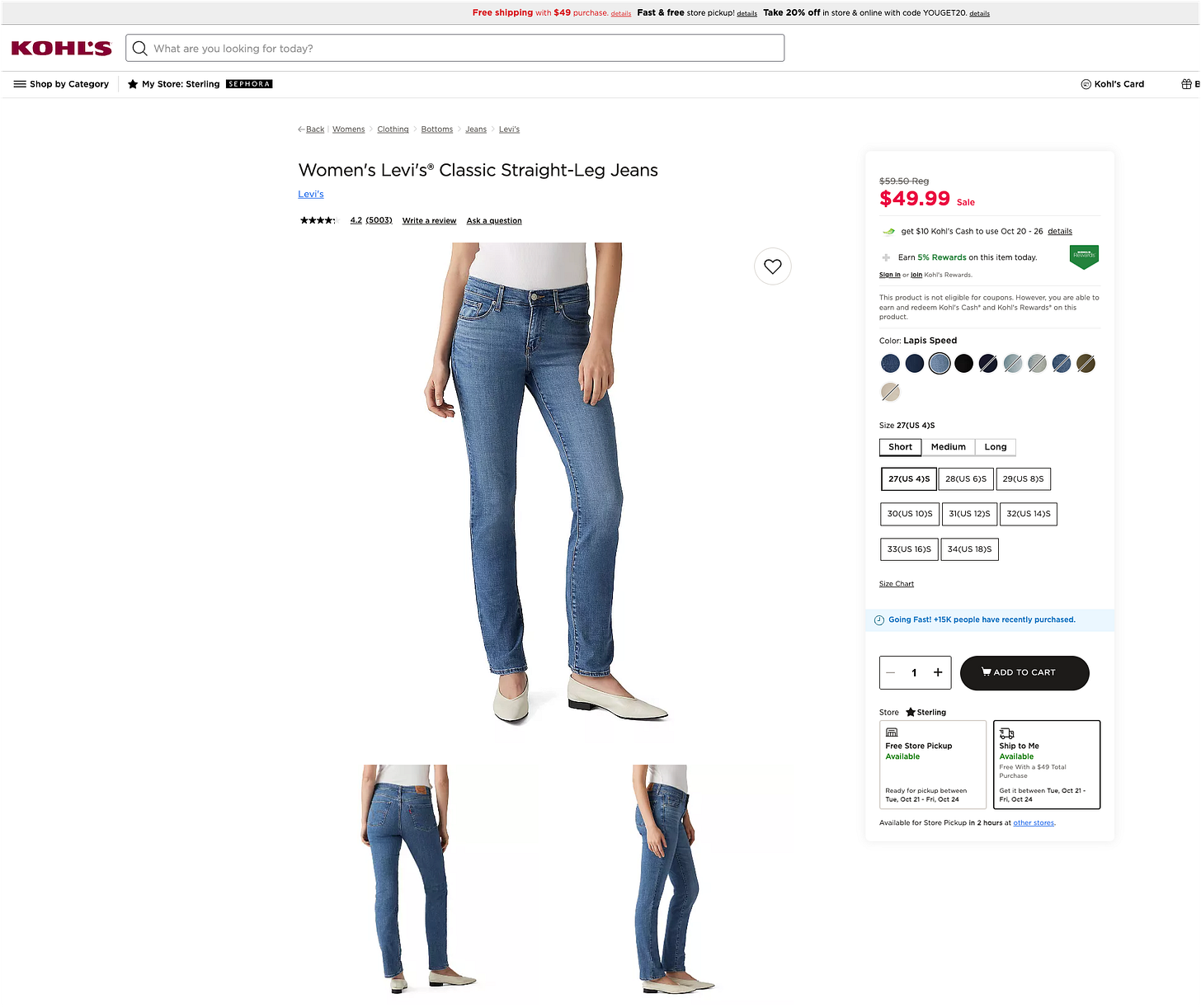





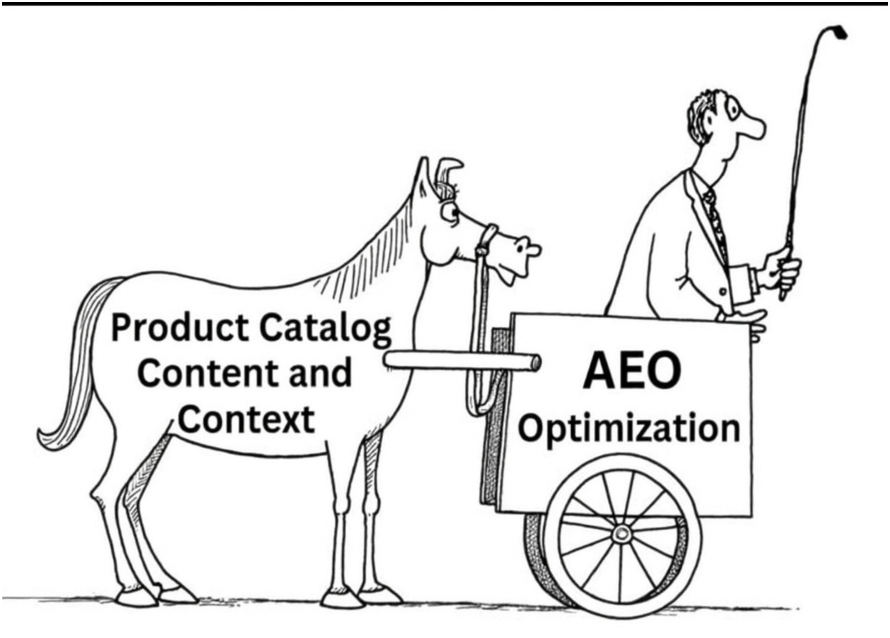
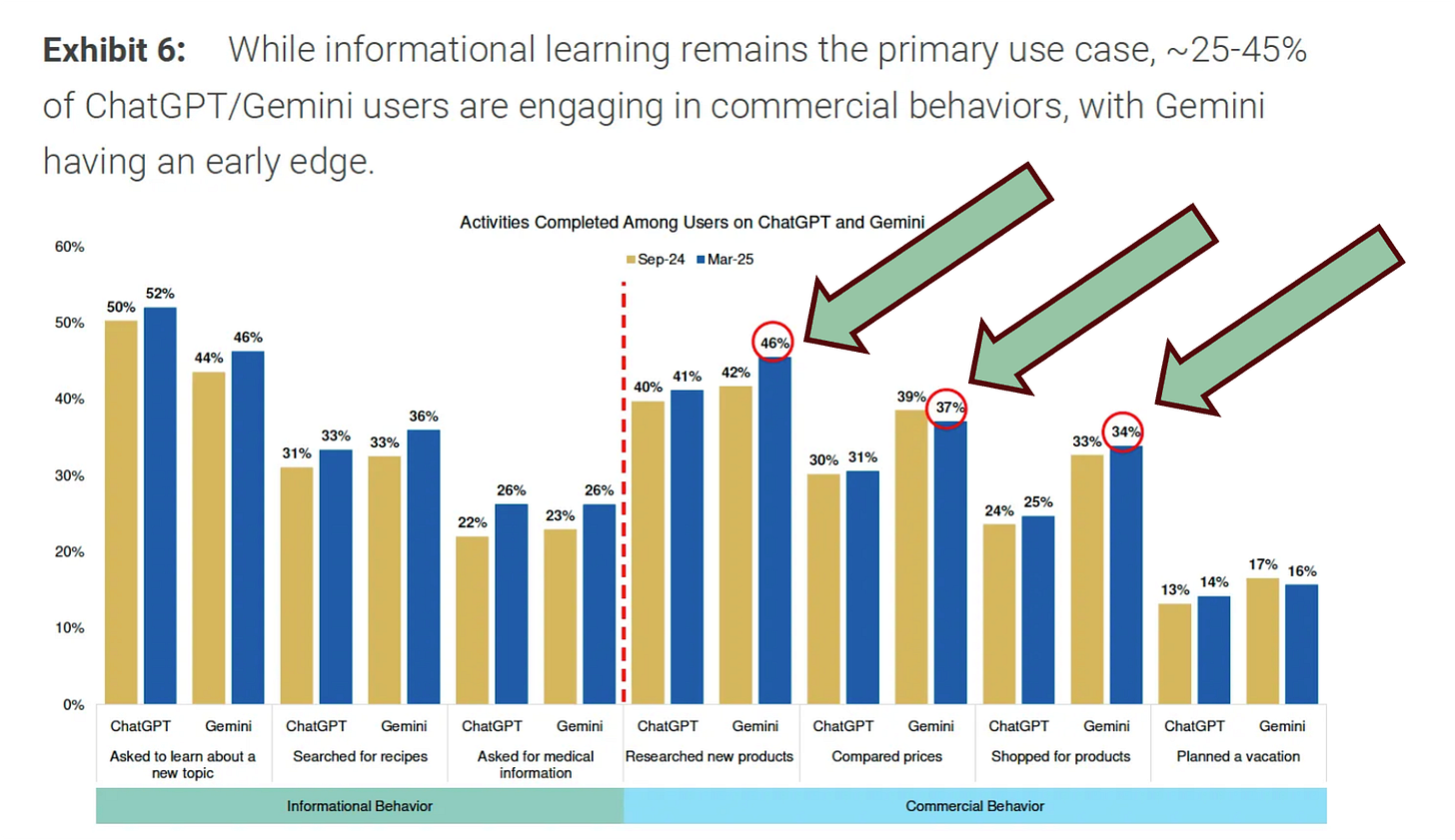
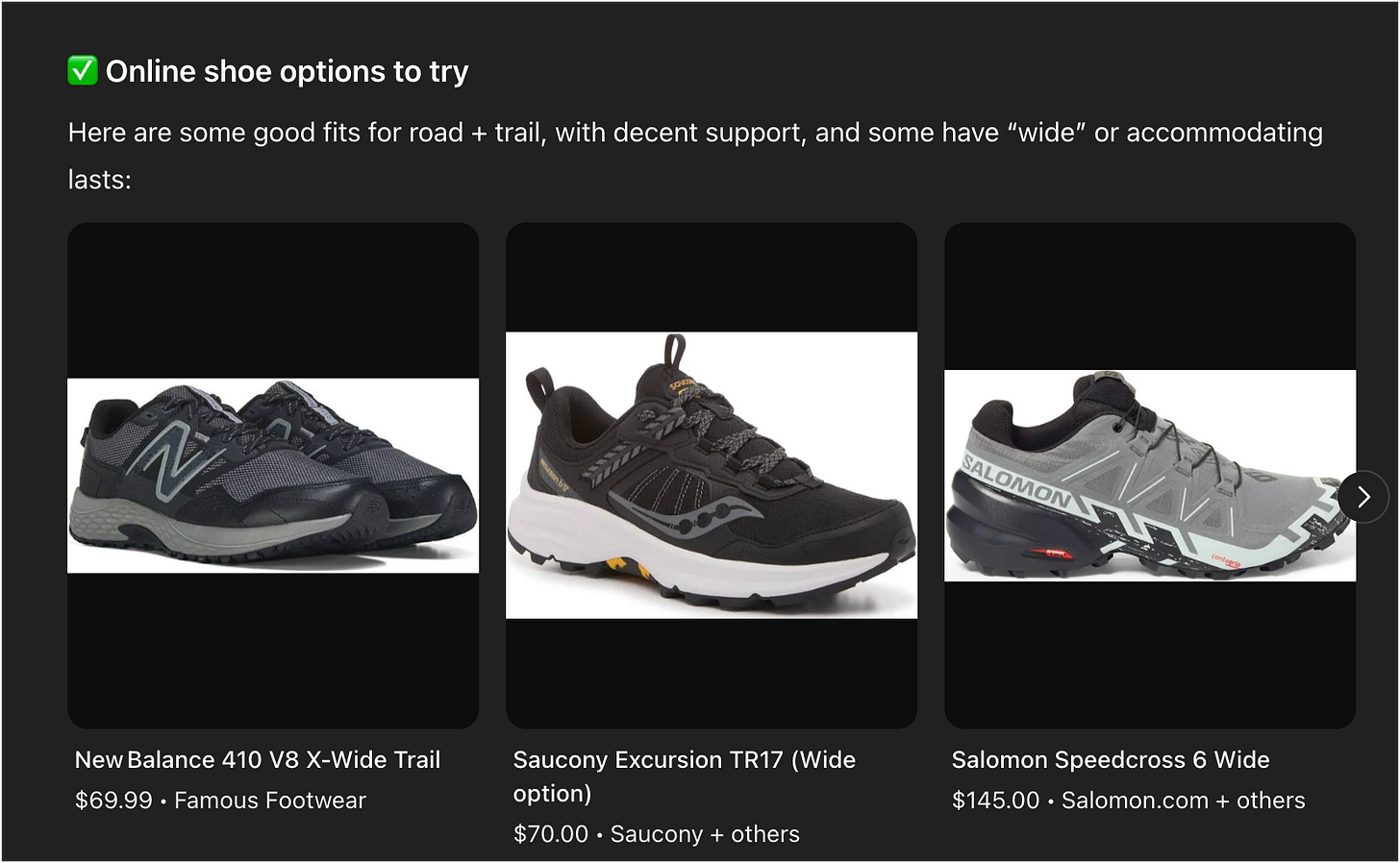

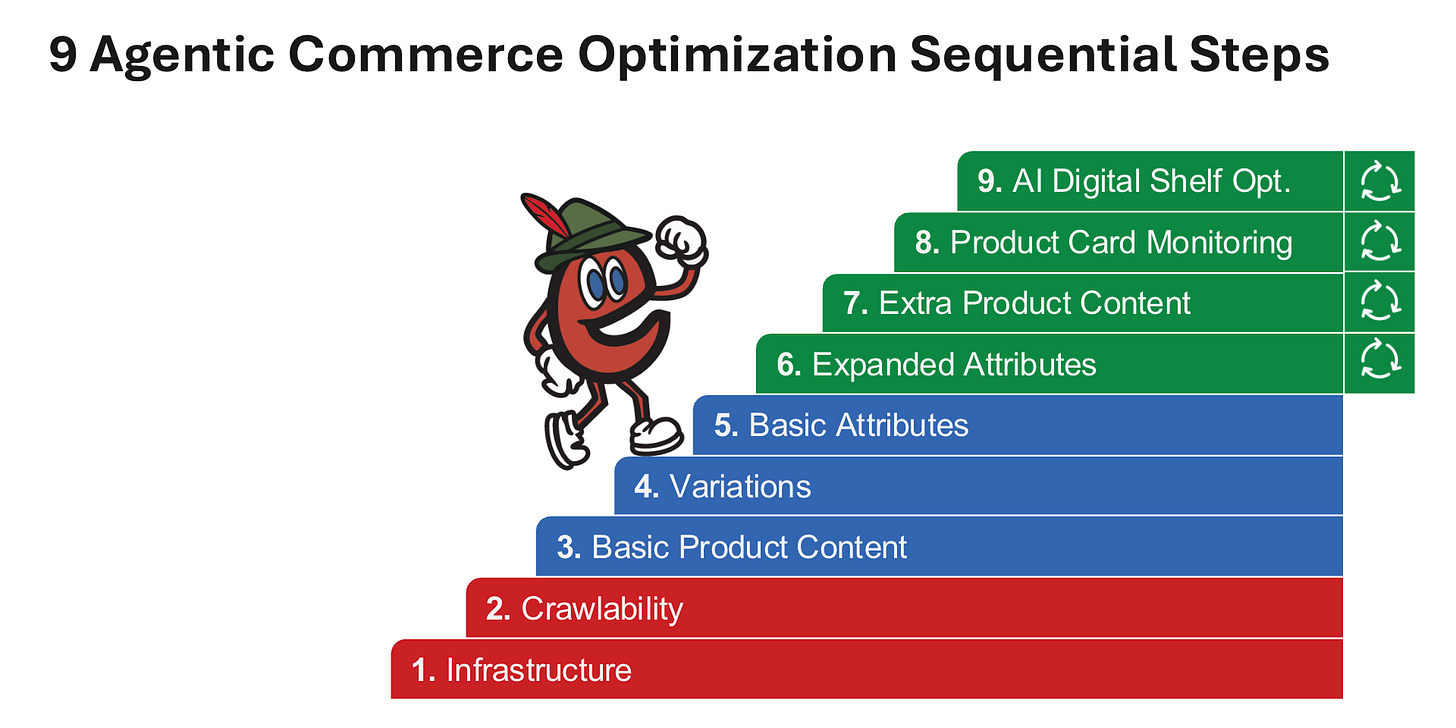
That 9/30/25 ChatGPT Instant Checkout insight totally hit home; you really have a pulce on where agentic commerce is going. With all this optimisation for sales, I wonder how we ensure these agentic sysems also empower consumers, not just retailers?